Notre Dame escaped with a victory on Saturday and can now enjoy some delicious cheeseburgers, but that doesn’t mean the film room is closed for the week.
The final score was too close for comfort on Saturday as Notre Dame’s hyper-efficient offense stalled out most of the afternoon before finally delivering the winning touchdown in the fourth quarter. As the title of this post suggests, we’re going to look at the good, the bad, and the ugly (and maybe end on a good so we don’t leave on a bad note) from the Pitt game.
The Good
Let’s begin by looking at two plays from Notre Dame’s first offensive series.
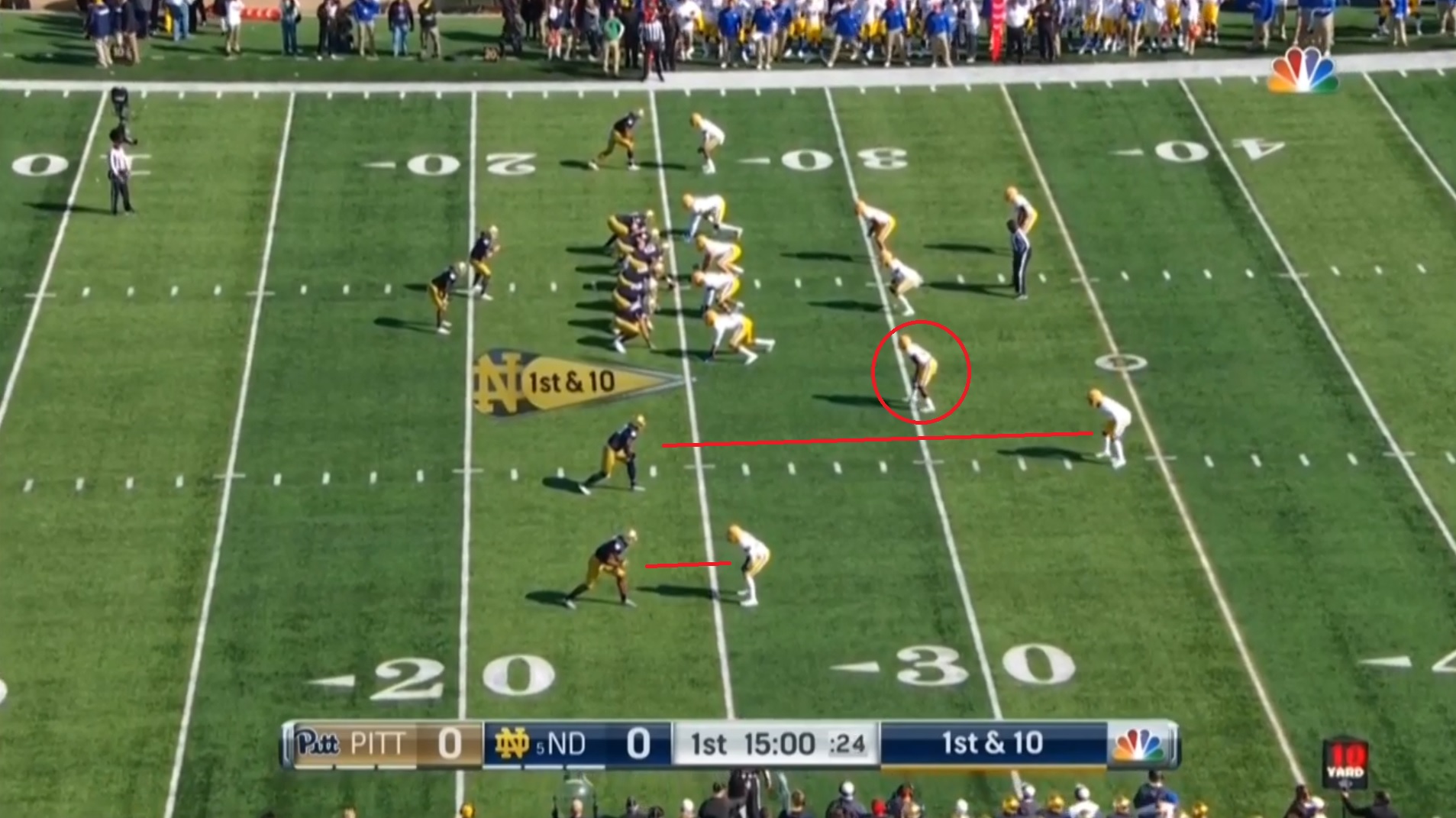
This play is a good example of Pat Narduzzi’s base defense. Notice how the cornerbacks are playing press coverage on the two outside receivers. Also notice how far off the safety over Alize Mack in the slot is lined up. And finally, check out the circled outside linebacker.
Narduzzi likes to use that linebacker to cover any short routes in the middle of the field and then use the safety to cover anything deep. This allows the linebacker to play close to the line of scrimmage to attack the run while taking away the quick passing game. At the same time, the corners press the outside receivers to take away easy throws such as curls or hitches.
(Long time readers might remember we talked about this style of defense many moons ago)
However, this defense is weak to RPOs. If the outside linebacker crashes on the run, the quarterback can make easy throws to the slot receiver. If he stays back, the defense loses the numbers advantage against the run.
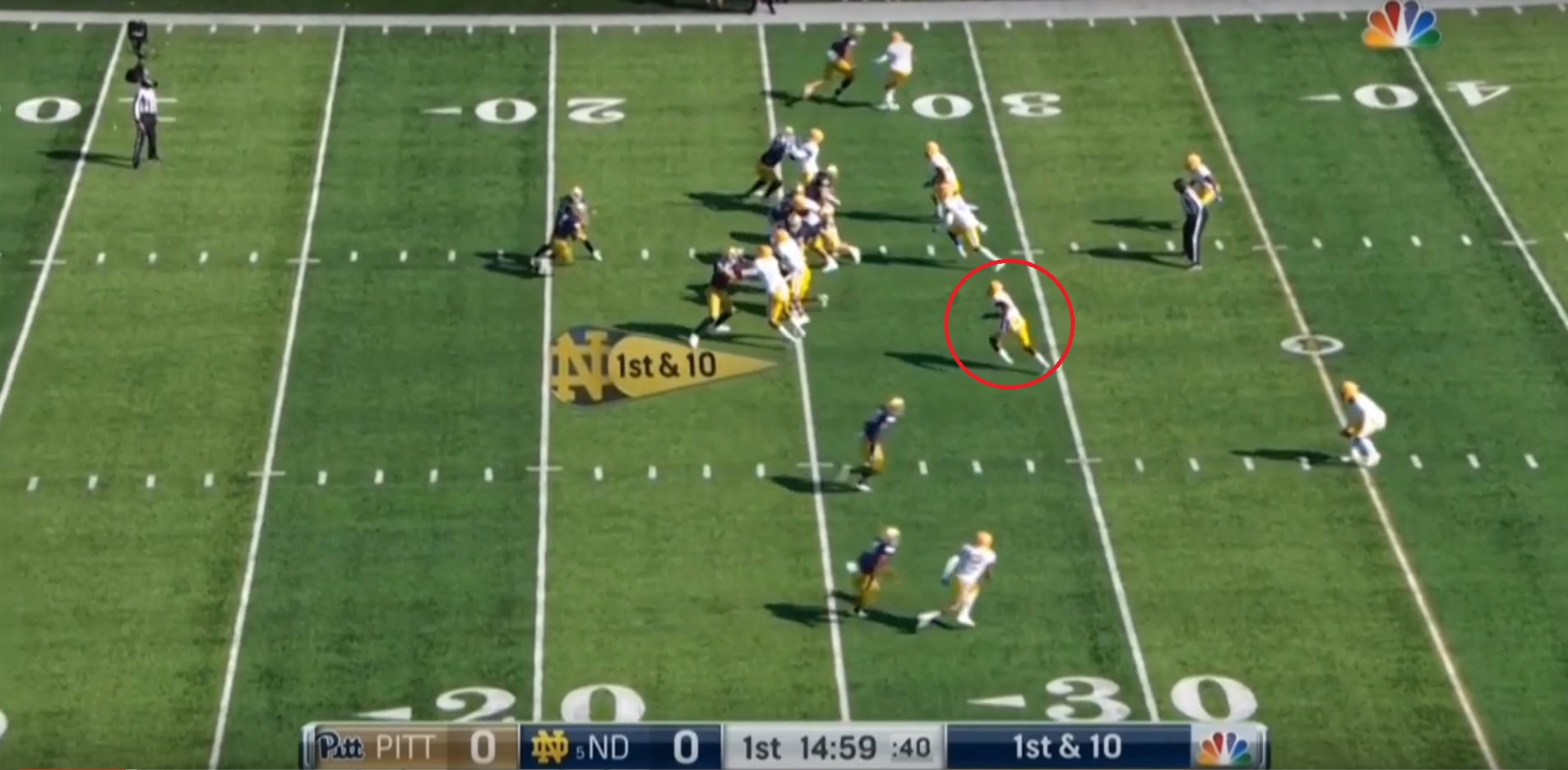
That’s exactly what Chip Long does. Book reads the linebacker on the hand off.
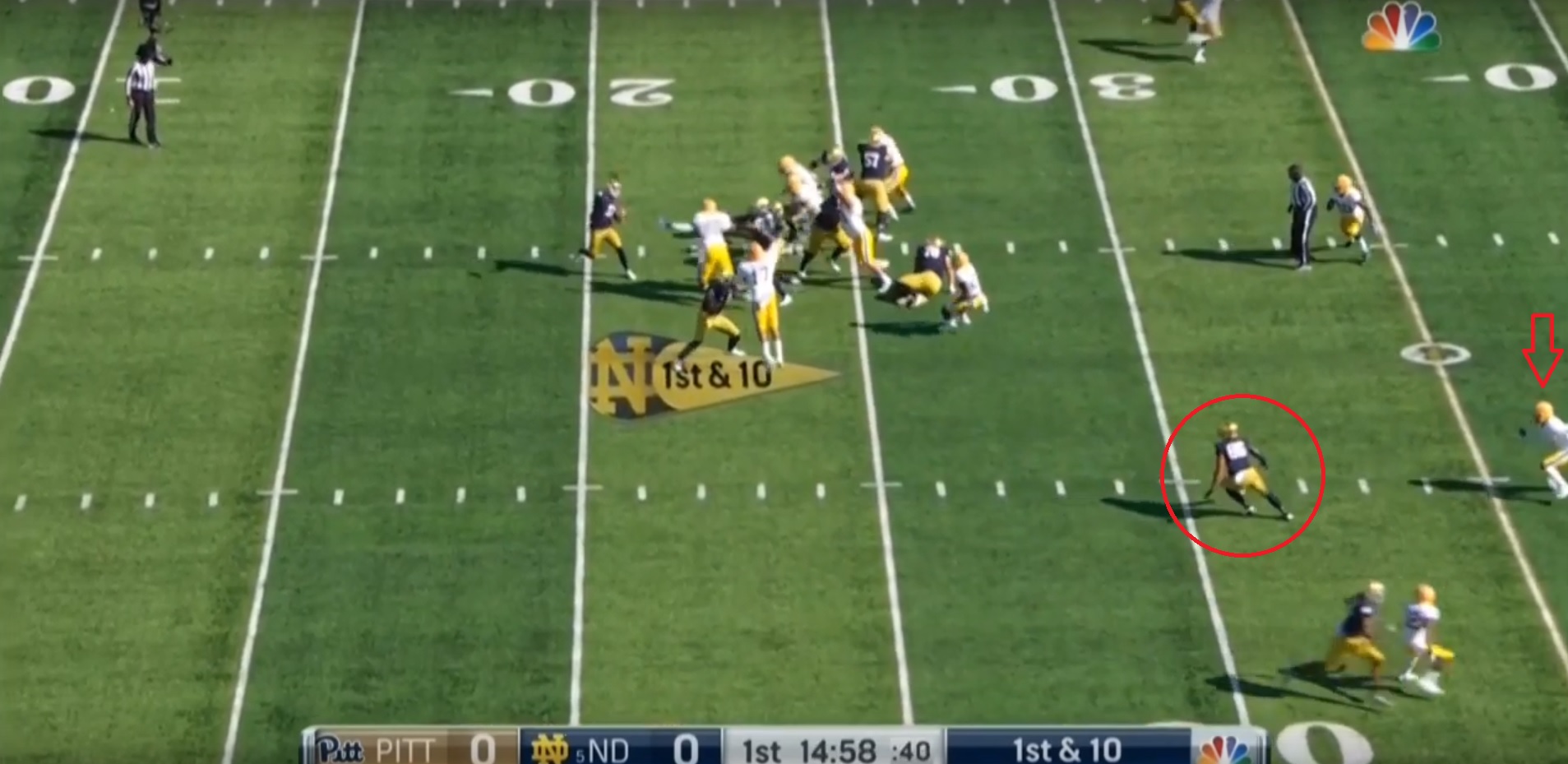
The linebacker comes crashing down to play the run. Alize Mack settles in the area the linebacker vacated. The safety (red arrow) is too far away to make a play. It’s not sexy, but it’s an easy six yards.
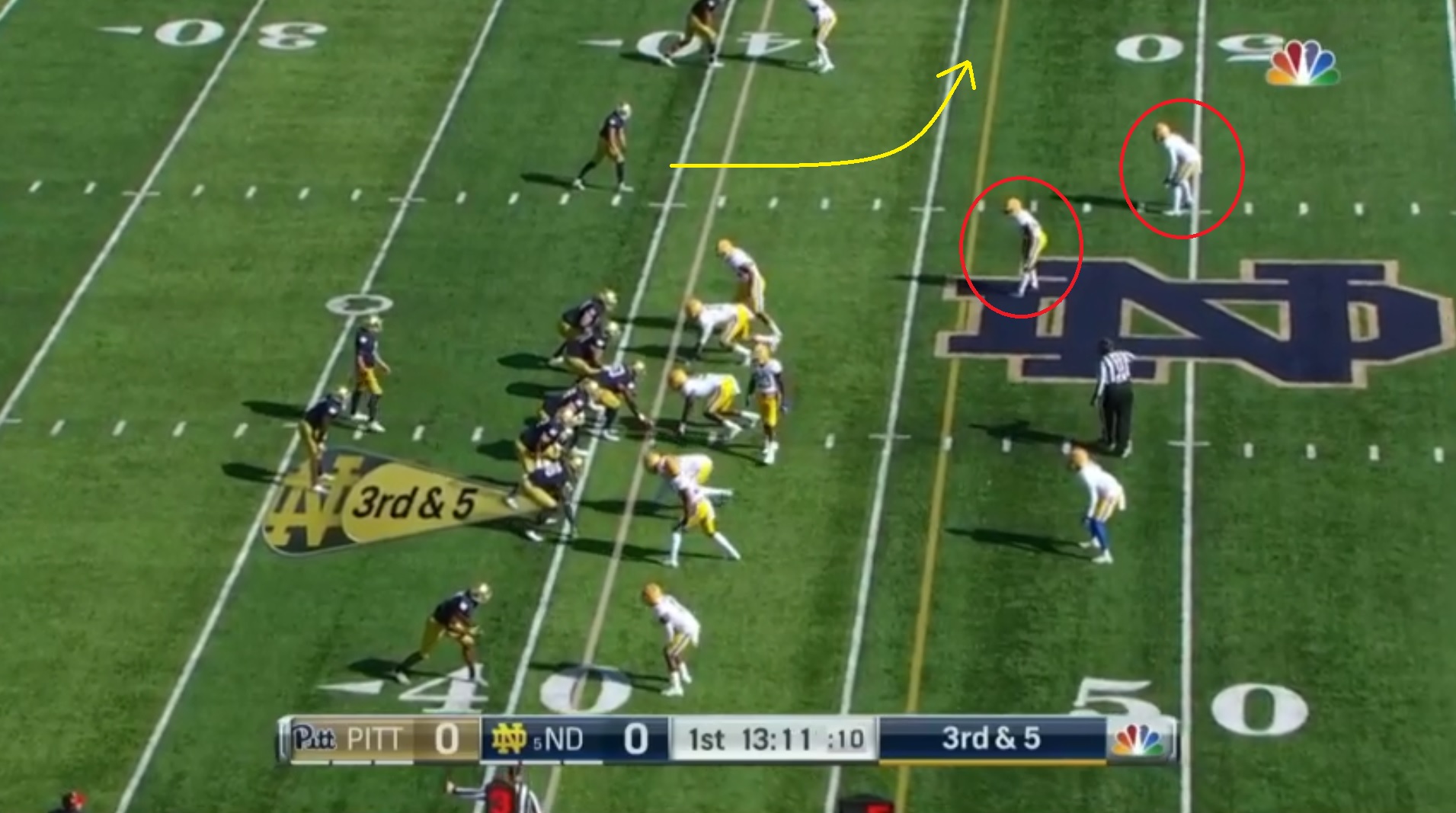
This next play takes advantage of the alignment of the linebacker and safety. With the linebacker shading inside and the safety playing deep, out routes from the slot are usually open. On this play, Chris Finke runs outside of the linebacker (circled) and underneath the safety (also circled).
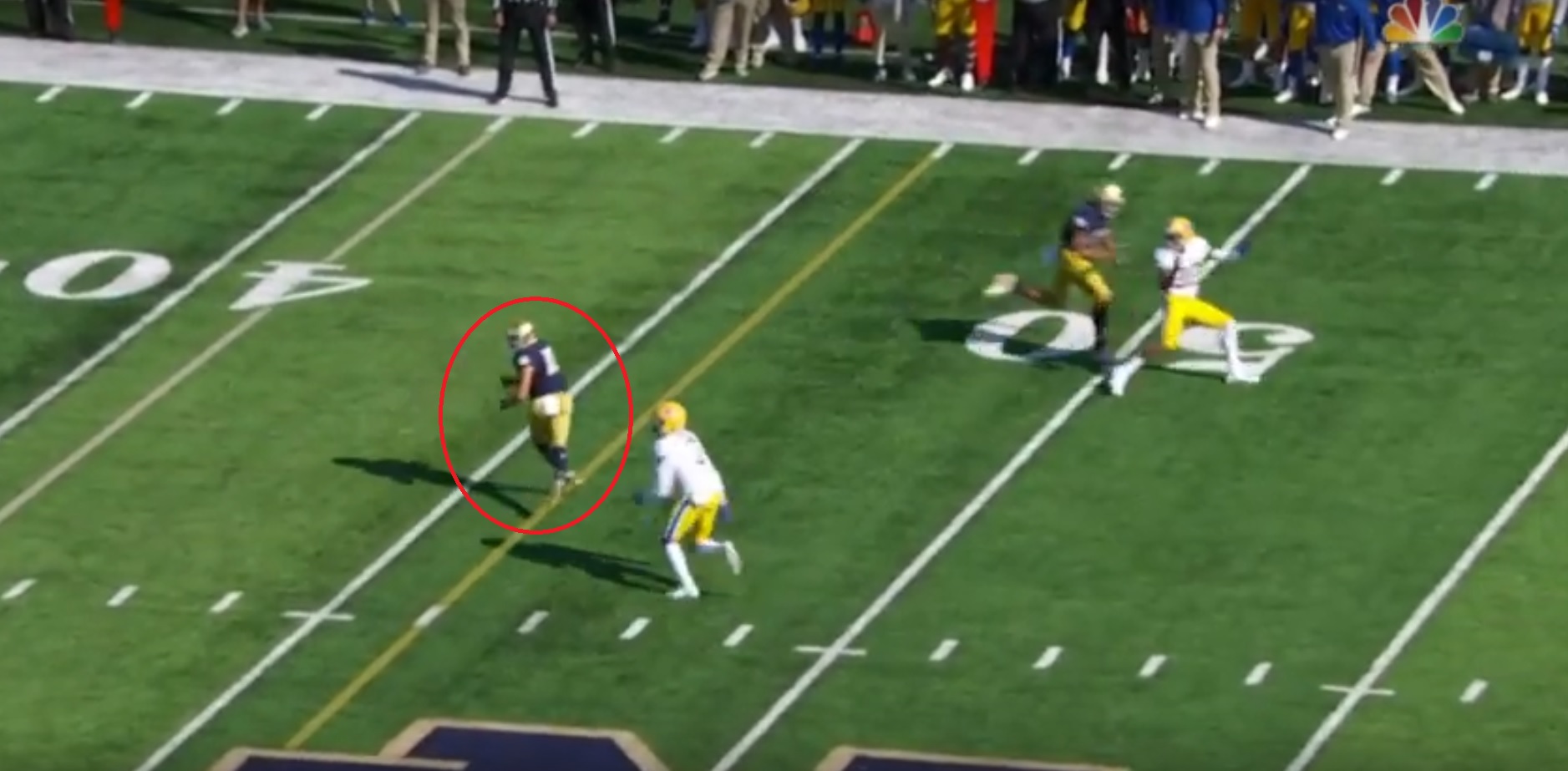
Sure enough, Finke has room and picks up an easy first down.
These two plays show that Chip Long knew what he was doing against Pitt’s defense. I have some issues with the play calling (which we’ll get into later) but Long had a solid plan going into this game.
The Bad
So the scheme was pretty good, but the offense still sputtered for most of the game. One issue was Book’s reluctance to throw the ball at times. His first interception is a good illustration of that problem.
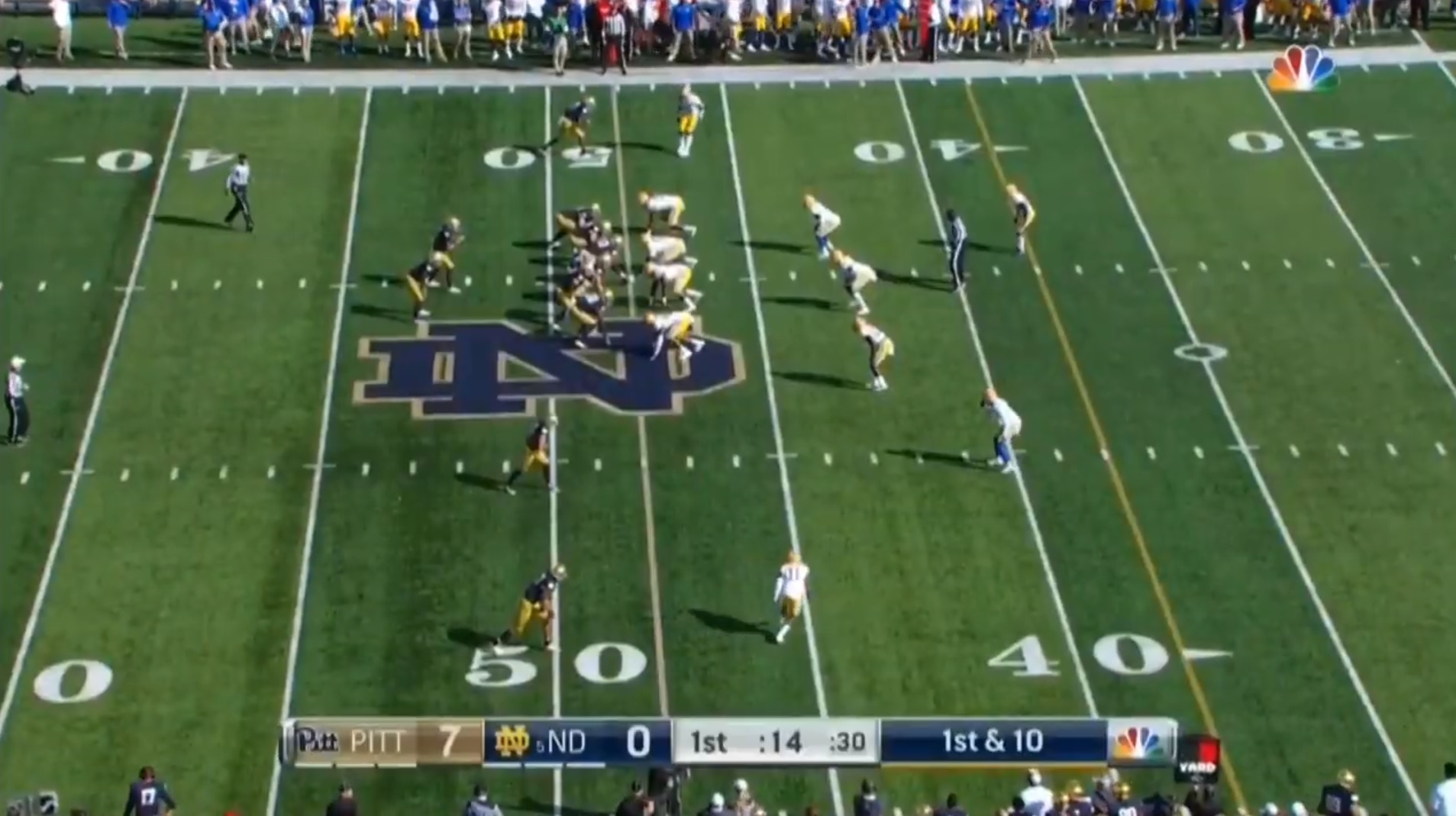
This is the same formation as the first play we looked at. This time Long calls a straight drop back pass instead of an RPO.
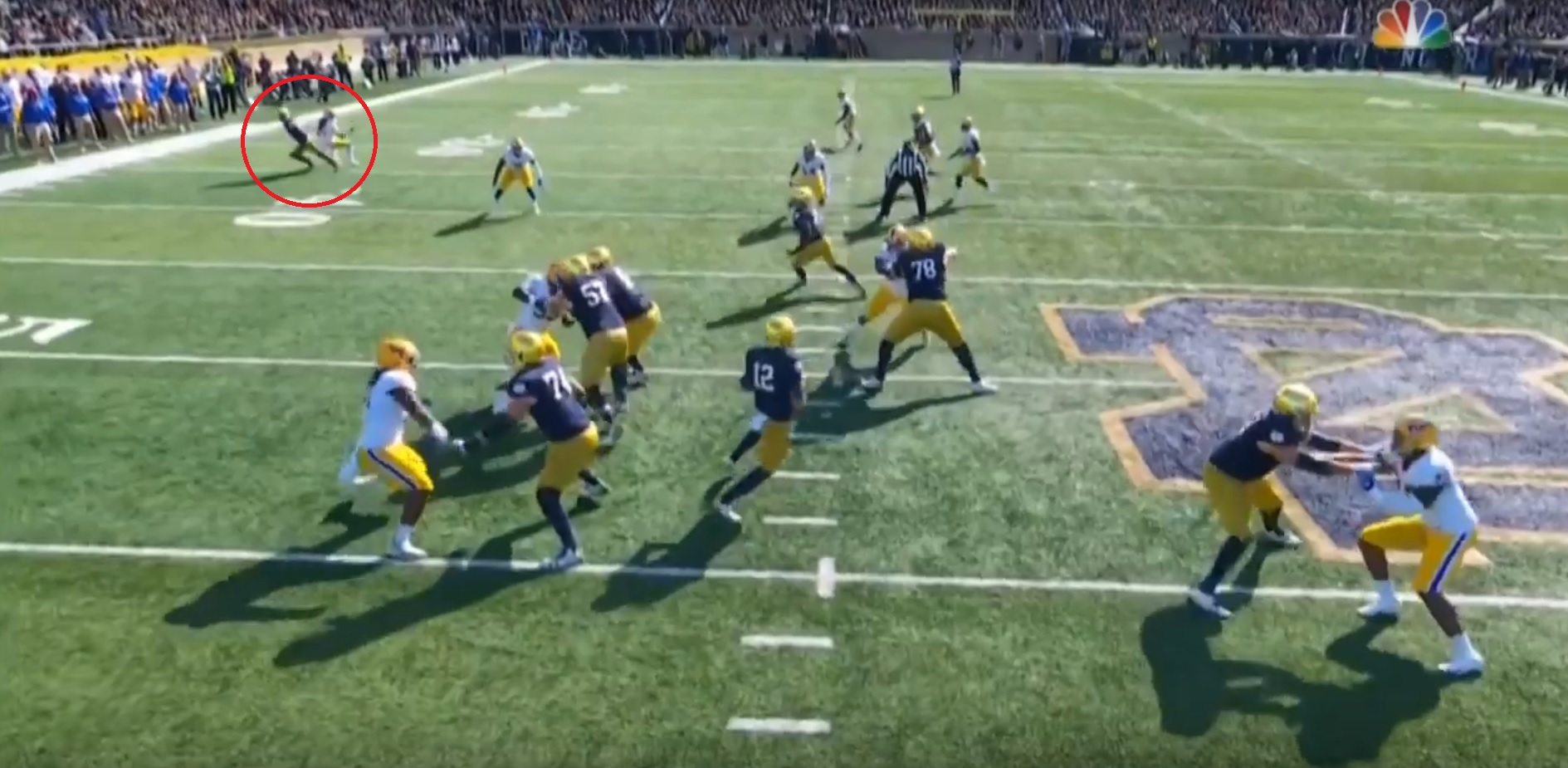
The first read appears to be Miles Boykin on a curl route. The corner is playing him tight, but there is space. It’s surprising Book didn’t throw the ball. It’s a tough throw – Book probably needs to throw it more towards the sideline to prevent the corner from breaking it up – but Book has thrown this before and Boykin has shown the ability to make tough catches if necessary.
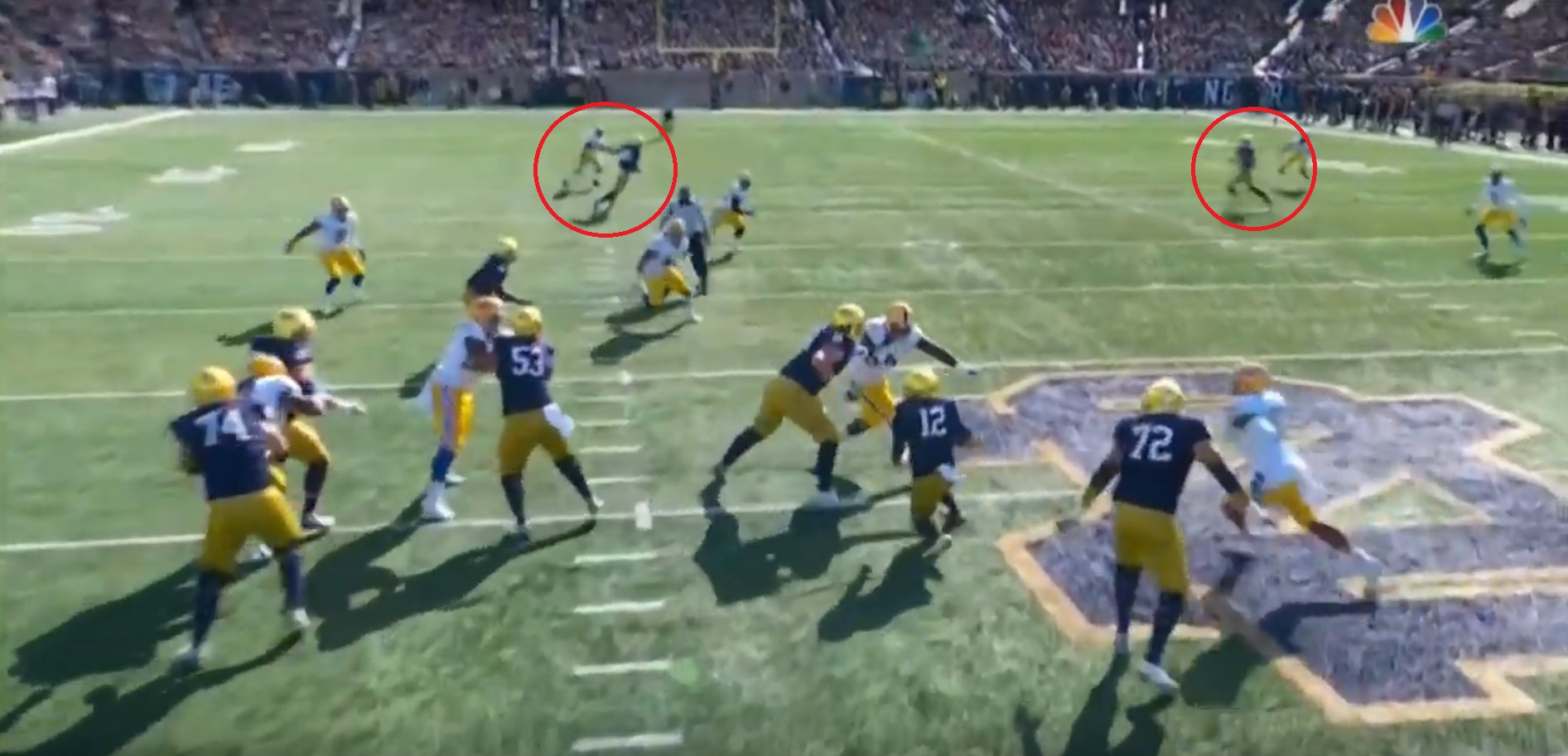
But Book comes off his read and decides to try and run towards the open space to his right. But right about here he realizes he can’t get through the hole and backtracks.
This is disappointing because if Book had just stayed in the pocket – he was getting excellent protection – Chris Finke was coming wide open to the right. He even could have thrown to Alize Mack in the middle of the field if he wanted.
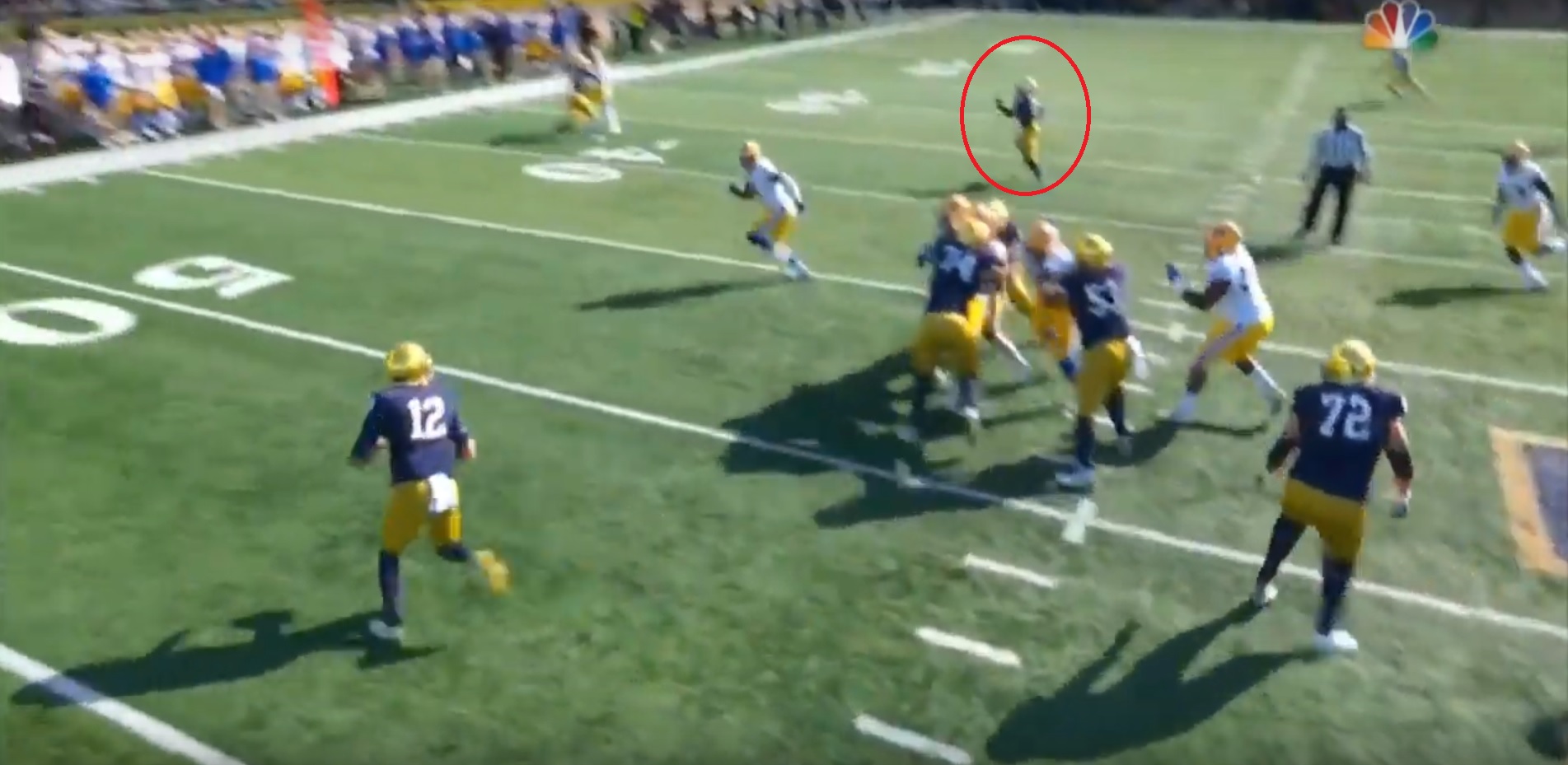
Book retreats from the pocket and still has Dexter Williams open as an outlet receiver. But Book can’t slow his momentum and square his shoulders fast enough.
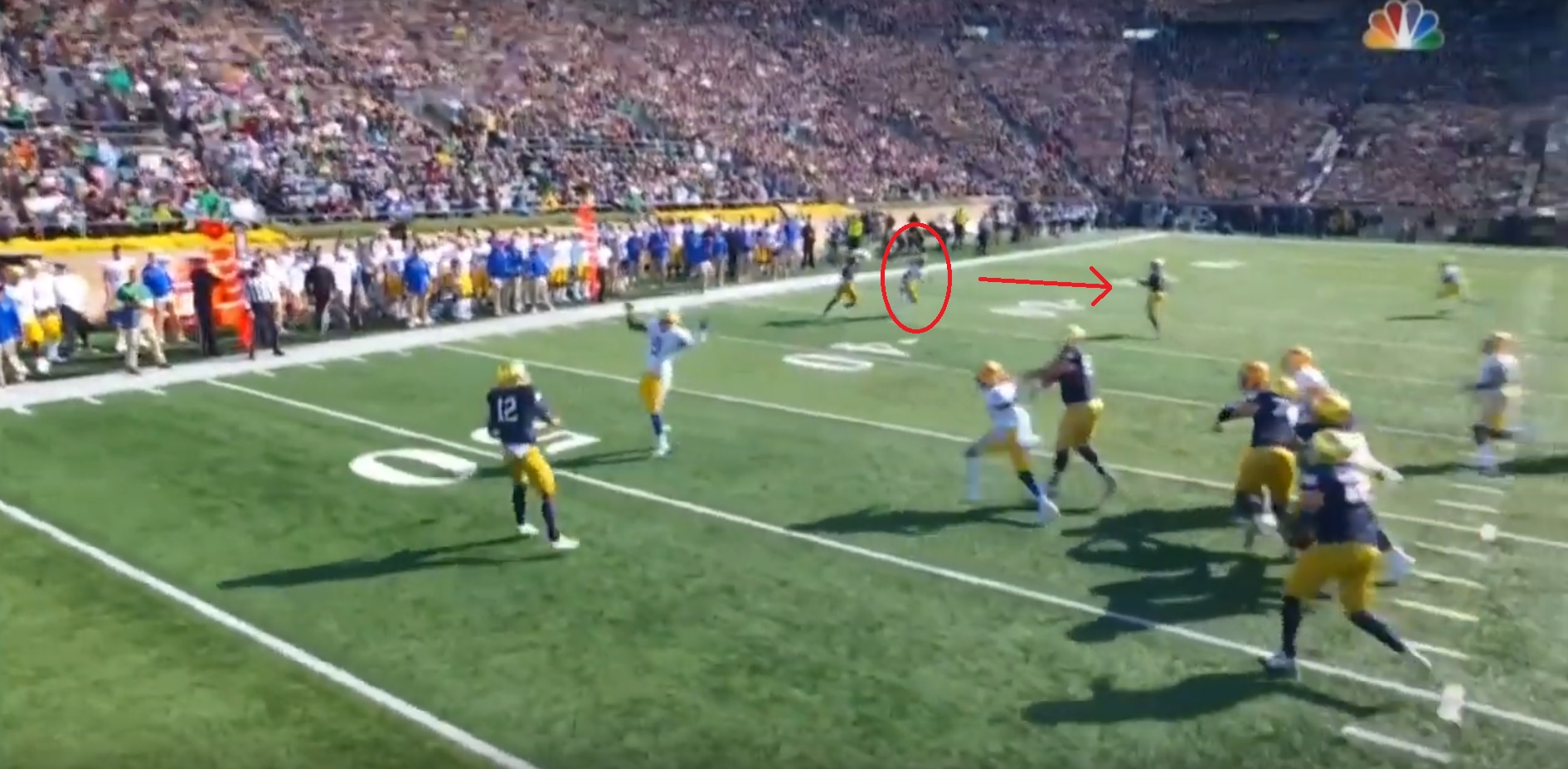
That gives the corner enough time to recognize Book’s intentions and come over for the interception.
This is odd because Book has being making quick decisions since he took the starting job. In fact, that was the reason he took over as the starting quarterback. But whether it was something Pitt did on defense or just a lack of focus, Book made some questionable decisions on Saturday. Book completed over 80% of his passes – which is amazing – but he also ran into a few sacks and didn’t pull the trigger on some plays.
The fourth down in the fourth quarter is another example. He probably could have hit either Brock Wright or Nic Weishar for the first down, but instead… ran out of bounds? That doesn’t go down as an incompletion but it was obviously a bad play. He needs to have the awareness to at least attempt a throw.
The Ugly
Ian Book didn’t have his best game, but he still put up stellar numbers and made plays to win the game.
The running game is a different story.
We discussed earlier how Pat Narduzzi likes to use an outside linebacker to get favorable numbers in the running game. But this isn’t a magic bullet. Worse teams than Notre Dame have run for a lot of yards on Pitt. There’s no excuse for running for 80 yards on Saturday.
What was especially bad was Notre Dame’s inability to run even when they had favorable numbers in the box.
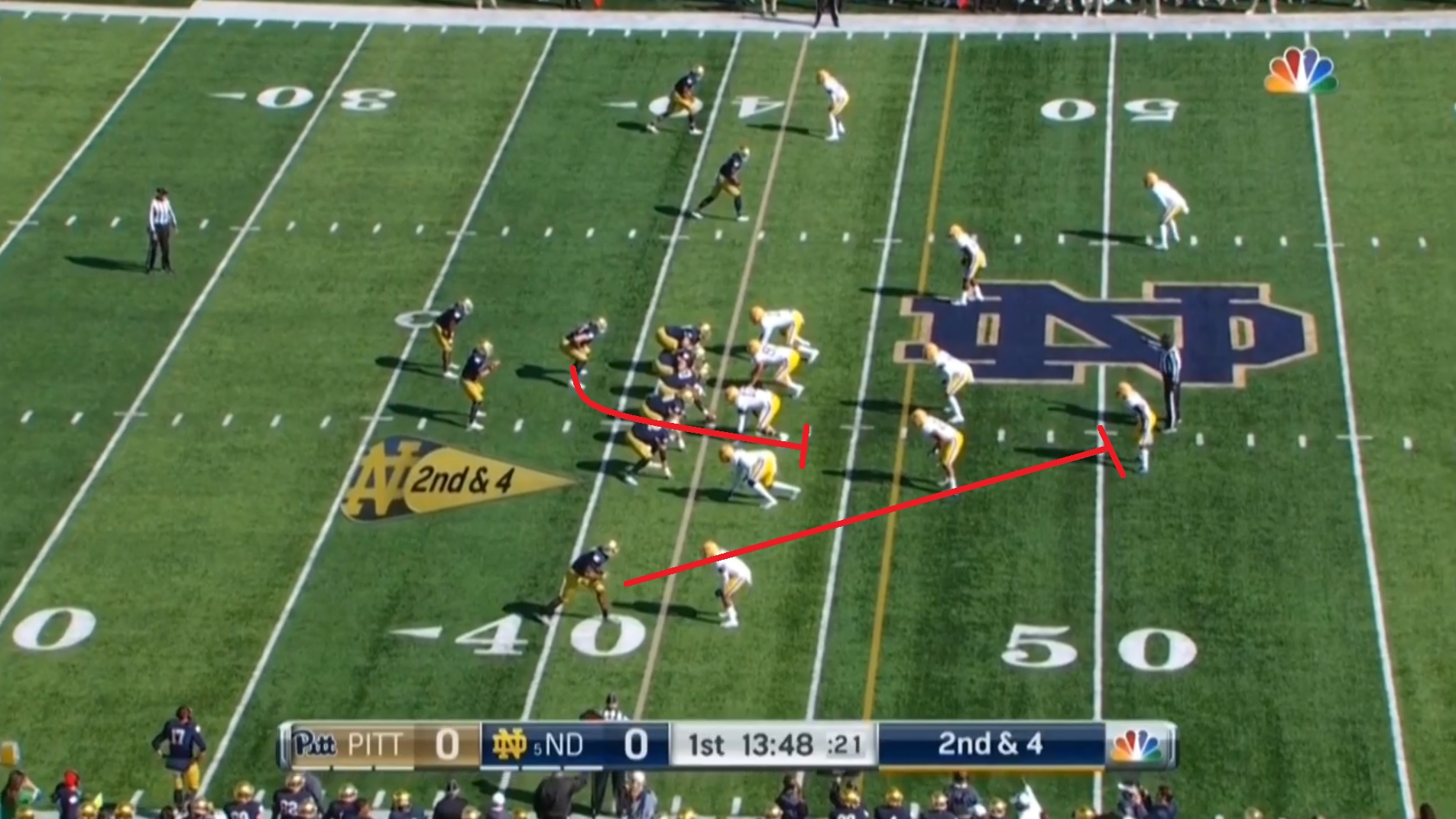
On this play, Cole Kmet wraps around and leads Dexter Williams through the guard-tackle gap, kind of like and old-school iso run. Pitt only has six defenders in the box versus six blockers, so this should be a successful run. One of Pitt’s safeties is playing somewhat close to the line but Miles Boykin blocks him, taking the corner with him.
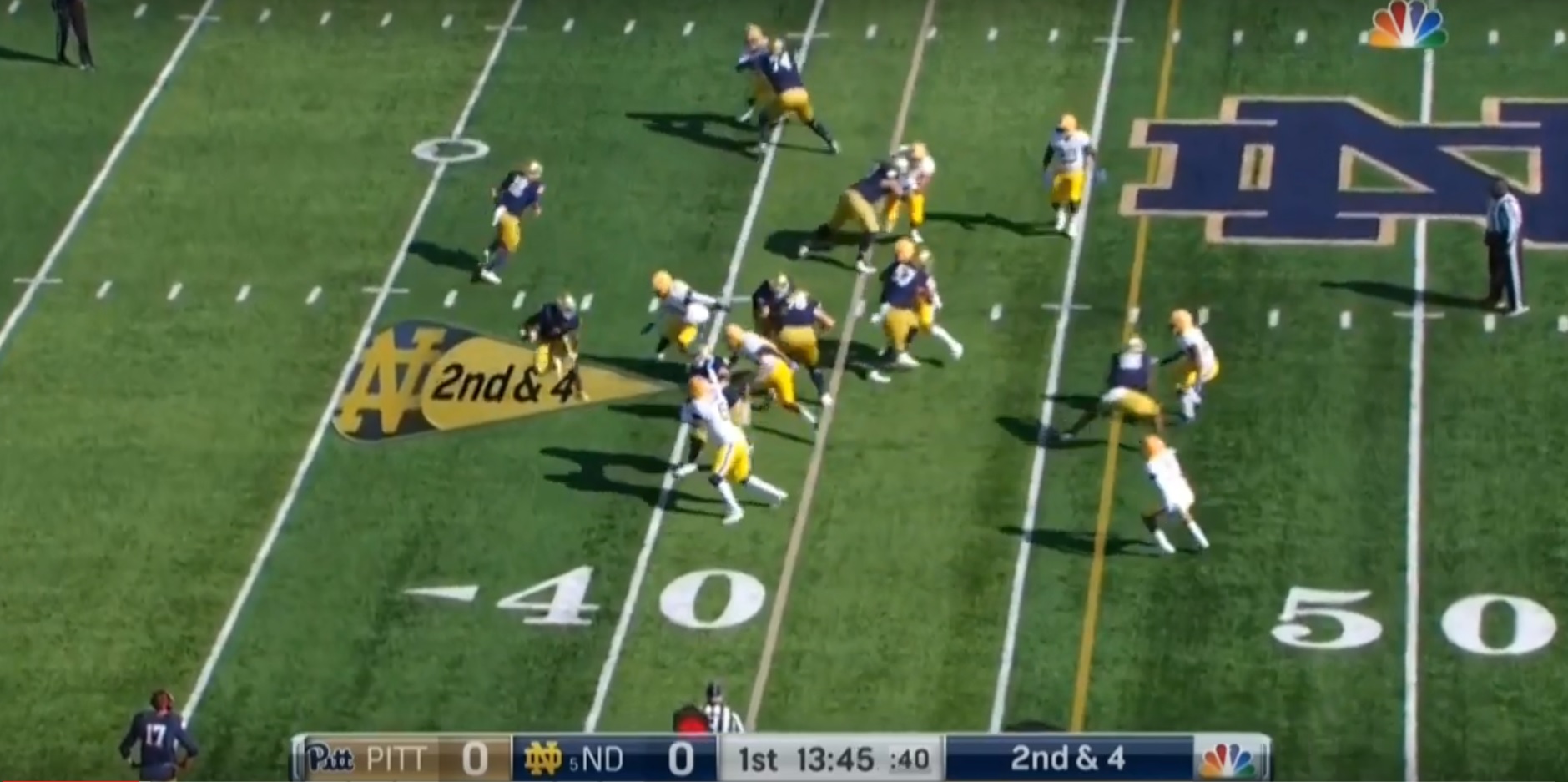
But this play is blown up at the line. Kmet doesn’t block anyone and Tommy Kraemer simply whiffs. With good blocking this is an easy first down. And if Dexter Williams gets to the second level, he’s probably one-on-one with the corner. One missed tackle and Dexter runs a long way.
This is quite bad, but I’m not on team #FireJeffQuinn. I think two issues are at play here.
First, the line really misses Alex Bars. He was Notre Dame’s best offensive lineman by far and his absence is noticeable.
Second, I don’t think Tommy Kraemer and Robert Hainsey are healthy. Hainsey missed time in fall camp and Kraemer sat out the Wake Forest game. I don’t think either one is 100% and hopefully they can recuperate during the bye week.
But Notre Dame needs to do a better job running the ball if they want to compete with the top programs in the country. Brian Kelly said after the game that they maybe should have thrown the ball more. I’m pretty results-oriented as opposed to process-oriented when it comes to the offense – if the offense moves the ball and scores points I’m happy – but simply ceding the run game to an opponent like Pitt doesn’t inspire confidence.
The Good (Again)
Things weren’t all bad on Saturday. As I said above, Ian Book didn’t have a great game (despite his final stats) but he still made some nice plays.
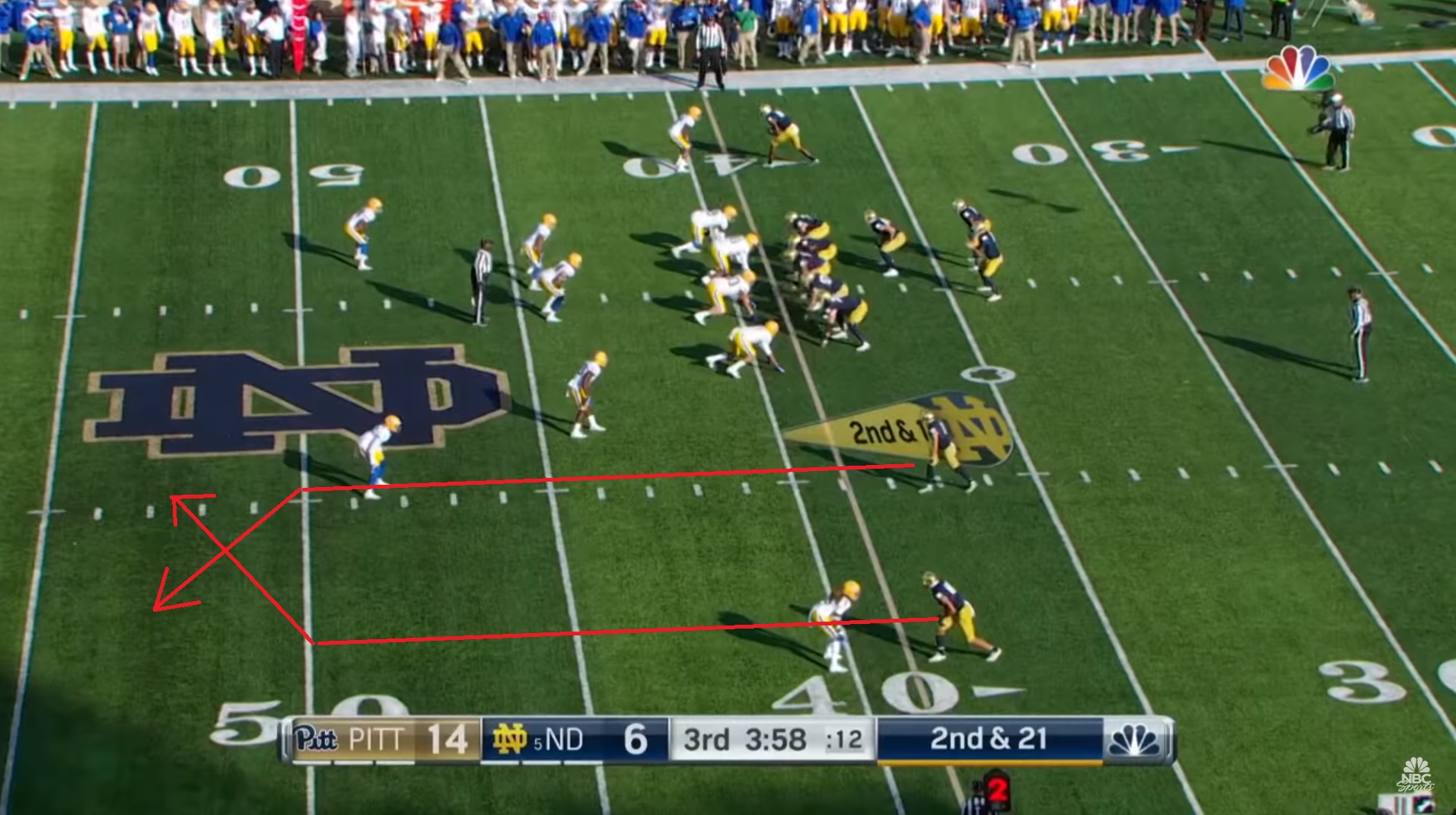
This play highlights Ian Book’s ability to make big plays when needed.
It’s 2nd and very long. Chris Finke and Chase Claypool run deep crossing routes.
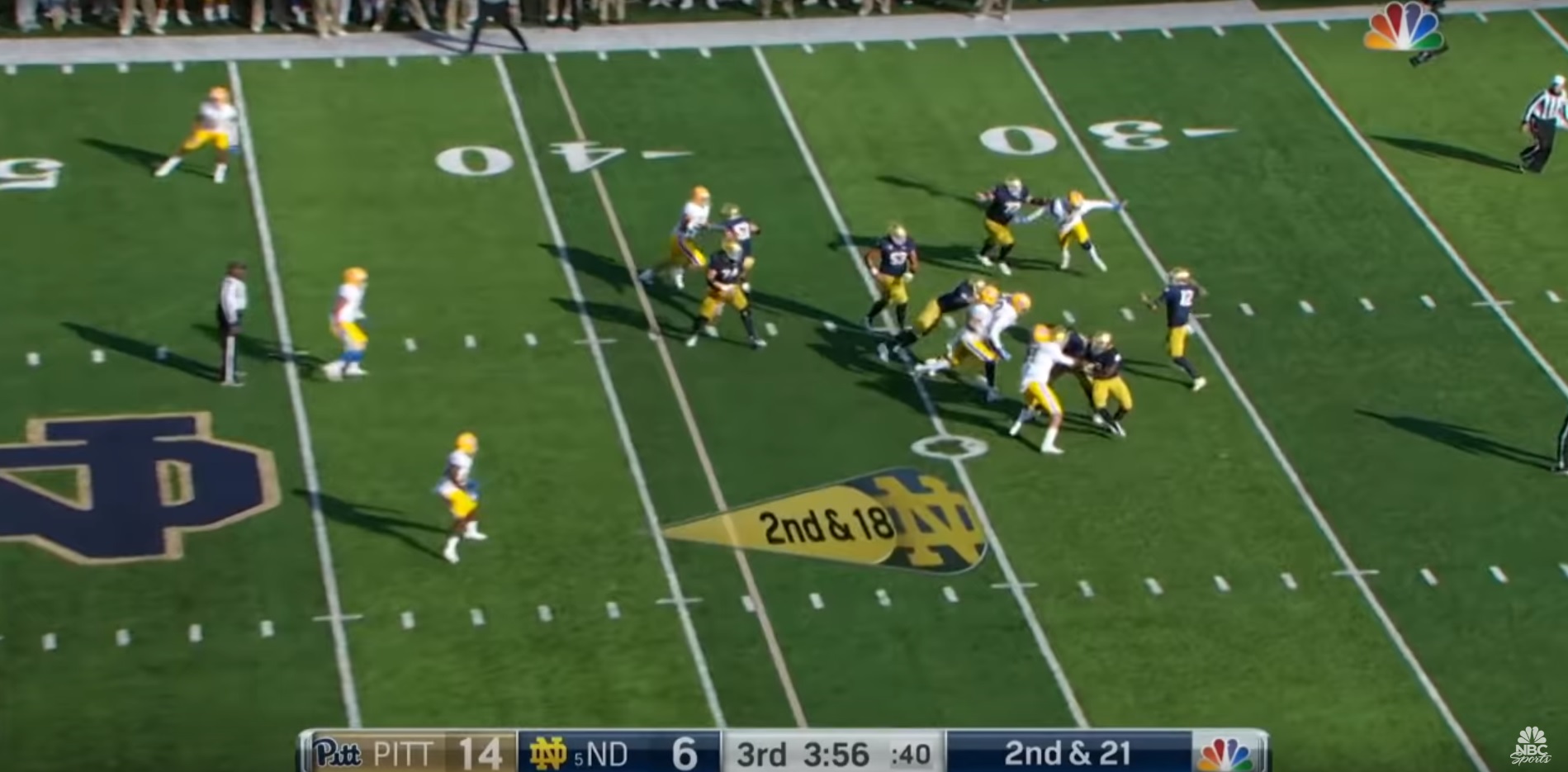
Protection breaks down and Book has defenders in his face. Earlier in the game, Book danced around and took sacks under pressure. But this time he keeps his eyes downfield, retreats backwards to give himself some room, and fires a pass to Chris Finke.
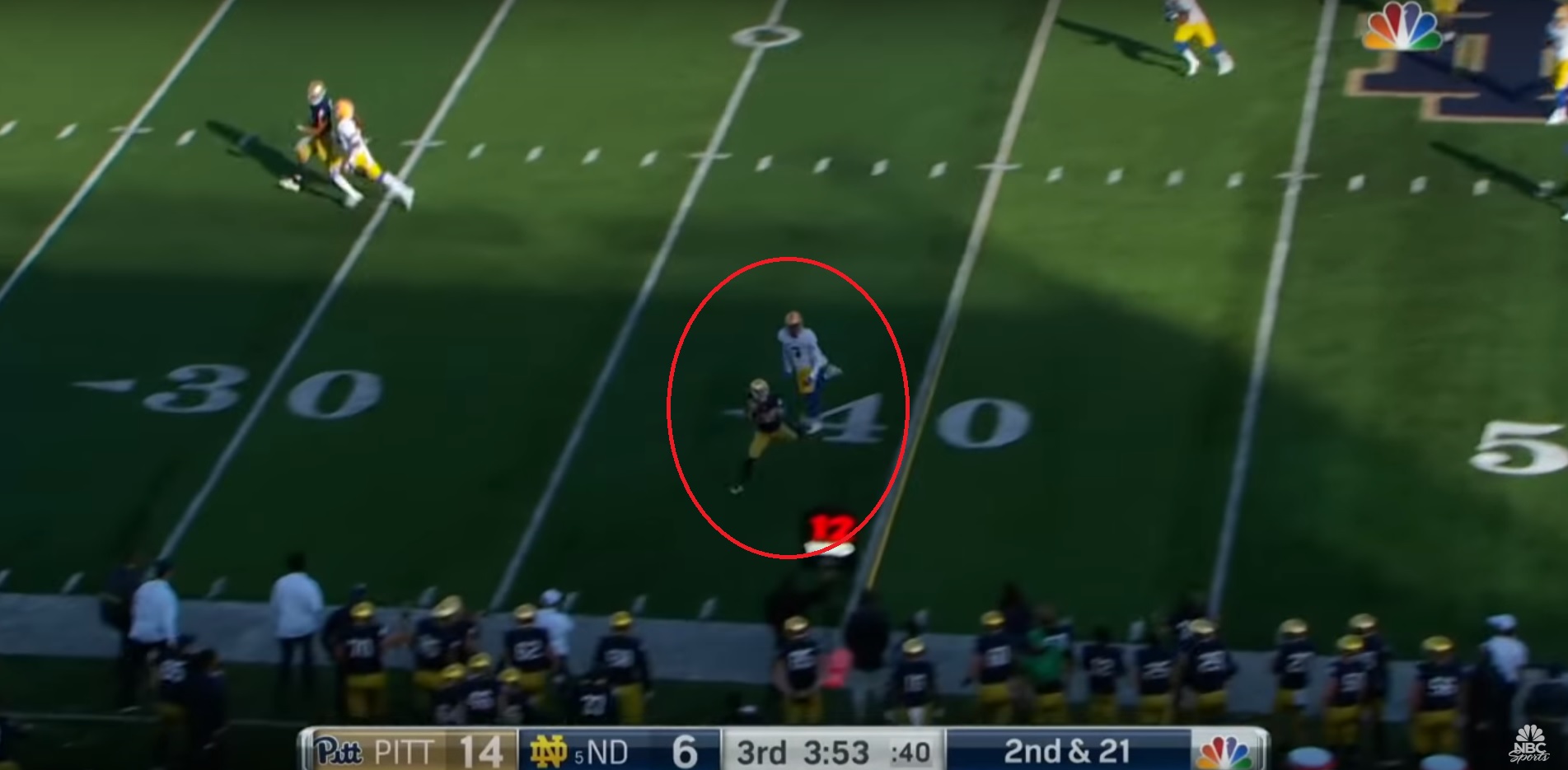
Book drops the pass perfectly into Finke’s arms. This drive would result in a touchdown to pull the Irish within 2. But that probably doesn’t happen if Book doesn’t stay calm under pressure and make a huge first down conversion.
Final Thoughts
I think the temptation is to look at the Pitt game and worry that we’re starting to see the offense break apart like it did after the Wake Forest game last year. At least, that was my first thought after the game ended. But after thinking about it, I don’t think that’s the case.
When Miami thrashed the Irish in South Beach, they exposed fundamental flaws in the offense. Brandon Wimbush was never a great passer. He had that really nice game against Michigan State and maybe that scared a few defensive coordinators enough to respect his arm. But Miami showed that if you sold out to stop the run, the Notre Dame offense had zero answers. The passing game simply wasn’t good enough to win games.
I don’t think we saw those kind of flaws on Saturday. A lot of Book’s problems are correctable. Bailing from the pocket too early, not pulling the trigger on a few throws – those are things that can corrected with film study and practice reps. Heck, the last play I highlighted showed Book is capable of making plays under pressure.
That said, the running game needs to get better. Eric discussed this at the end of his Pitt review and I agree with his thoughts. I’m not sure how far an entirely Book-centric offense will take Notre Dame.
But we’re 7-0 and enjoying cheeseburgers this week, and that’s not a bad place to be.

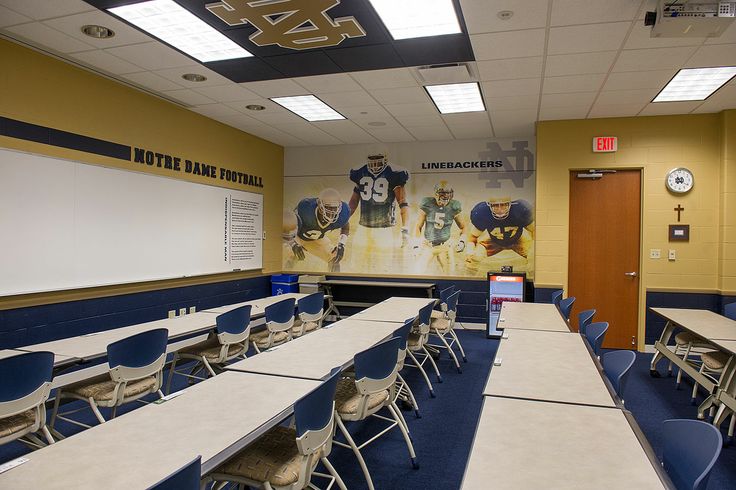



Thanks, nice write up, much appreciated. I don’t understand why the line had so much trouble vs Pitt. I guess those two you mention could be hurt, but given how weak Pitt has been against the run i’d Think their backups would have been thought capable for this specific game.
I guess not.
I am likewise concerned about the running game. I can’t decide if my concern lies more with the coaches or the players, but they’ve had some poor games against poor teams, contrasted with some good games against both good and bad teams. How can the same team run for 270 against Stanford, but only 80 against Pitt?
No Alex Bars, no Jafar Armstrong, a banged up Tony Jones, and a player who has never had to carry the load as a primary back (Dexter). Hopefully the bye week will help with a lot of those problems. But yeah, it’s definitely concerning. You would hope that they could have done something – anything – versus a mediocre at best defense.
88.3 percent from 9 yards and closer. Pretty good.
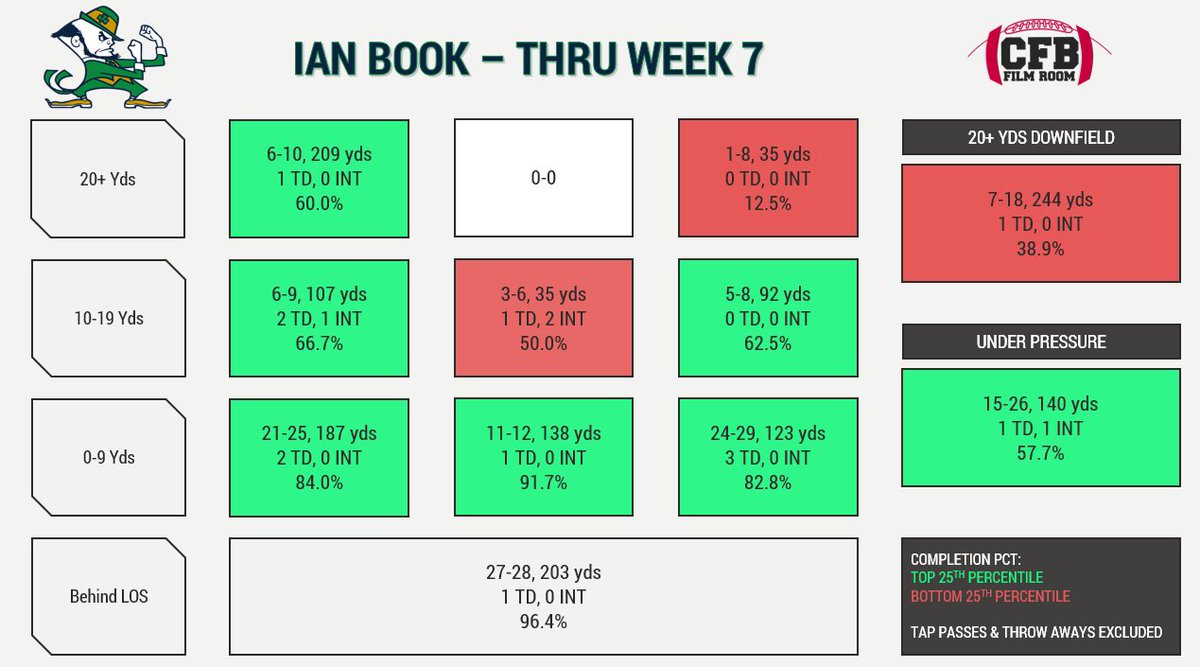
This is a great find man. Thanks for adding it to the discussion here.
How about he just doesn’t throw 20+ yds to the right? Do we move Boykin/Claypool much, or Boykin always play left side and Claypool always play right?
Also, no more 10-19 yd passes over the middle (I assume this is the most intercepted box for all QBs).
2017 LSU agrees with you.
Small samples, random noise. Run the full offense, don’t do anything different.
Mine will be a Shake Shack Linkburger (one meat patty, one Pecan Lodge Smoked Sausage Patty), with lettuce, tomatoes, pickles, onions, cherry peppers, and shack sauce, fries, a diet coke, and double dip of SS vanilla frozen custard, which is like if ice cream and an angel had a baby. Seriously where has frozen custard been all my life. Actually it’s probably for the best that ours is an October-Octobet romance.
“Seriously where has frozen custard been all my life.”
St. Louis – It has been in St. Louis. Specifically, Ted Drewes.
I went there after my buddy’s wedding this June. Yummmmm
Are you from St. Louis? I just moved to the area about 2 years ago.
Not from there, but lived there for 10 years. .25 mile from Ted Drewes on Chippewa.
In-laws are in St. Louis – always have to make a stop at Ted Drewes when in town.
Love the analysis Burger — I like the walk through the good and bad plays! I wonder if we might see any changes on the o-line coming out of the bye week?
Maybe we’ll see more Aaron Banks? I’m not an o-line expert but I don’t feel like Ruhland has been bad, but Banks probably has more upside. A healthier Kraemer and Hainsey probably won’t hurt either.
I considered that pass to Finke as one of the turning points in the game.
Yup. What happens if he doesn’t complete that pass, or even takes a sack? We almost certainly punt. And who knows what happens.
Super off topic, but with everyone now talking about Nick Bosa not returning to OSU, Gil Brandt asked Jaylon Smith if he would do something similar and he said this:
“If I knew that I was going to get hurt and wasn’t going to be a top-5 pick again, I would have literally played in that game again because of my teammates and how much Notre Dame means to me.”
As much as I love ND, we didn’t deserve that guy.
LMFTFY: Brian VanGorder didn’t deserve that guy.
That has to be the biggest waste of a player in ND history. Nay, in the history of sport.
Excellent article! My biggest concern is the running game and, specifically the O line. They have been very disappointing the last few games. Commentator Bryan Driskel said that it looks like their technique has been bad – and not just Rhe right side – even Mustipher. I have no way of knowing. Do you see that?
I don’t have much faith in Driskel.
They look slow to me, specifically Kraemer and Eichenberg
I think PFF graded Eichenberg very high in this game. I don’t know their grading system, but that’s positive/
I’m not an expert on o-line technique, so I can’t comment on that. But if it is as bad as Driskel says, then the coaches certainly have seen it too.
True. Plus, I have to think that the line,en, especially vets like Mustipher, know good vs bad technique when they see it on film. Hopefully, it is something that can be corrected over the bye week.